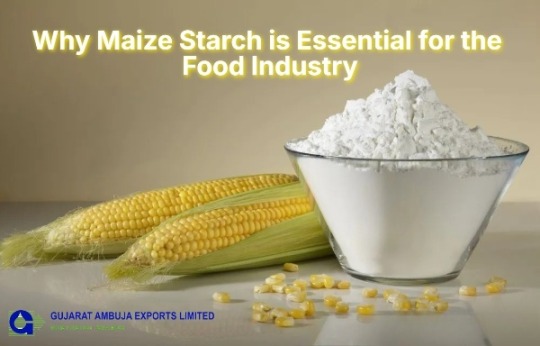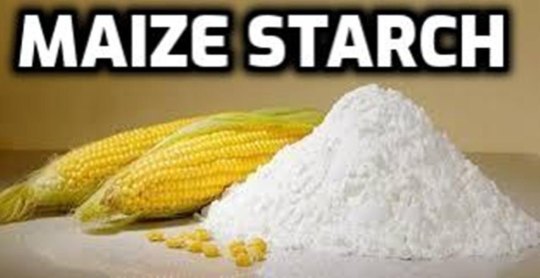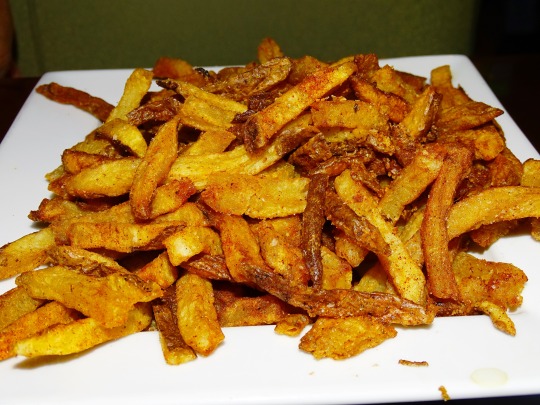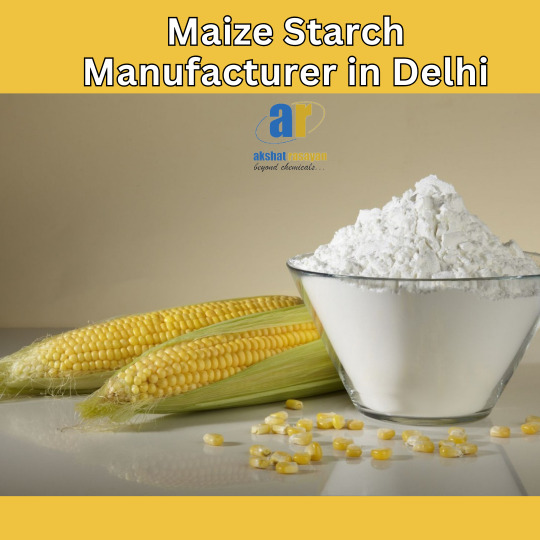#Maize Starch Production
Explore tagged Tumblr posts
Text
The Importance of Maize Starch in the Food Industry

Introduction
Maize starch is a vital ingredient in the food industry, playing a key role in many food products due to its various properties. Its ability to thicken, stabilise, and provide texture makes it an essential component in both everyday and specialty foods. This blog explores its uses, benefits, and importance in food processing.
What is maize starch used for?
Maize starch is used in various applications, including as a thickening agent in sauces, soups, and gravies and as a stabilizer in dairy products like yogurt and dressings. Its neutral taste and ability to blend smoothly into mixtures make it a staple ingredient in food processing.
Is Starch Good or Bad?
Starch, including maize starch, is often debated regarding health. While it's a source of carbohydrates that provides energy, it should be consumed in moderation, like any nutrient. In food processing, maize starch offers benefits, such as providing the necessary texture and structure to foods without adding unhealthy fats or sugars.
Composition and Properties of Maize Starch
Maize starch is composed primarily of carbohydrates in the form of amylose and amylopectin. These two components give maize starch its unique thickening and binding properties. Its ability to absorb water and form a gel makes it highly useful in many food products, allowing it to enhance texture, consistency, and stability.

Role of Maize Starch in Food Processing
In food processing, maize starch serves as a thickening agent in products like soups, sauces, and gravies. It ensures a smooth consistency and prevents ingredients from separating. Additionally, as a stabilizer, it helps maintain the structure of products like dairy items, sauces, and salad dressings, preventing them from breaking down over time.
Maize Starch as a Texturizer
Maize starch is also crucial in contributing to the texture and mouthfeel of various foods. For example, it is used in gluten-free and specialty diets to replace the texture lost when gluten is removed. Its ability to add volume and structure without altering taste makes it an essential ingredient for creating satisfying gluten-free products.
Nutritional Aspects of Maize Starch
Maize starch is a source of calories, providing energy to the body. It is a carbohydrate, which is necessary for daily functioning, especially in physically demanding activities. While it lacks significant vitamins and minerals, some processed maize starch products may contain dietary fiber, offering benefits such as improved digestion and supporting gut health.
Maize Starch in Food Preservation
Maize starch also plays an important role in food preservation by extending the shelf life of products. Its moisture-retaining properties help prevent foods from drying out, while its ability to stabilize emulsions helps to prevent spoilage. This makes it a valuable ingredient for manufacturers looking to keep products fresh longer.
Economic Impact of Maize Starch in the Food Industry
Maize starch is a cost-effective ingredient compared to other types of starch, such as potato or wheat starch. Its affordability makes it a preferred choice in large-scale food production. By keeping production costs down, maize starch helps to keep food prices competitive while maintaining high quality.
Innovations and Trends in Maize Starch Usage
The demand for maize starch continues to evolve, with emerging applications in food technology, such as in the production of plant-based foods and clean-label products. Ongoing research is aimed at improving the properties of maize starch, including enhancing its stability under extreme processing conditions and developing new functional uses.
Who is the manufacturer of maize starch in India?
Gujarat Ambuja Exports Limited (GAEL), established in 1991, is a manufacturer of maize starch in India. GAEL offers high-quality maize starch and corn derivatives to industries around the world. With a focus on quality and innovation, GAEL plays a significant role in the agro-processing industry and is trusted by manufacturers globally.
Why Choose Gujarat Ambuja Exports Limited for Maize Starch?
GAEL's commitment to quality, combined with advanced manufacturing processes and a deep understanding of the food industry, makes it the best choice for maize starch. With a long-standing reputation for delivering reliable and high-quality products, GAEL is a preferred partner for food manufacturers seeking top-tier starch products.
Conclusion
Maize starch is essential in the food industry for its thickening, stabilizing, and texturising properties. Its ability to improve food quality, shelf life, and cost-effectiveness makes it a valuable ingredient. With companies like Gujarat Ambuja Exports Limited leading the way, the future of maize starch looks promising, with innovations enhancing its applications across various industries.
For inquiries, contact: Phone: +91-79-61556677 Email: [email protected]
#Maize Starch#Corn Maize Starch#Maize Starch Manufacturer#Maize Starch Exporter#Maize Starch Production#Maize Starch for Food Industry#Maize Starch in Pharmaceutical Industry#Maize Starch in Food Industry
0 notes
Text
Drilling Modified Starch Ahmedabad | Top Modified Starch Ahmedabad - Chem Fert Chemicals
Are you looking for Drilling Modified Starch Ahmedabad? Chem Fert Chemicals is best manufacturer of drilling modified starch Ahmedabad, India. For know more about starch ahmedabad call us on 07 4900 00334.
Modified Starch Ahmedabad, Drilling Modified Starch Ahmedabad, Top Modified Starch Ahmedabad, Modified Starch Ahmedabad, Modified Starch Product, Modified Starch Powder Manufacturer Ahmedabad, Wheat Modified Starch Ahmedabad, Maize Modified Starch Ahmedabad, Modified Starch Powder in Ahmedabad, Modified Starch Ahmedabad, Manufacturer of Modified Starch Ahmedabad, Chem Fert Chemicals
#Modified Starch Ahmedabad#Drilling Modified Starch Ahmedabad#Top Modified Starch Ahmedabad#Modified Starch Product#Modified Starch Powder Manufacturer Ahmedabad#Wheat Modified Starch Ahmedabad#Maize Modified Starch Ahmedabad#Modified Starch Powder in Ahmedabad#Manufacturer of Modified Starch Ahmedabad#Chem Fert Chemicals
3 notes
·
View notes
Text
High-Quality Starch Products: Bluecraft Agro, Your Trusted Starch Supplier

Starch is a vital ingredient in a wide range of industries, from pharmaceuticals to food processing, and even in manufacturing. The demand for high-quality starch products has significantly increased, and businesses rely on trusted suppliers to meet their needs. If you are looking for the best starch supplier for pharmaceuticals or need modified starch for food processing, Bluecraft Agro is the name you can trust.
High-Quality Starch Products for Diverse Industries
At Bluecraft Agro, we specialize in producing and supplying high quality starch products that meet the rigorous standards of various industries. Whether you're in pharmaceuticals, food production, or manufacturing, our starches offer superior performance and reliability. We understand that quality and consistency are essential, and that’s why our starches undergo thorough testing to ensure they meet the highest standards.
Best Starch Supplier for Pharmaceuticals
Pharmaceutical companies require starch that adheres to strict quality and safety regulations. Bluecraft Agro is proud to be the best starch supplier for pharmaceuticals, offering starch products that are non-toxic, stable, and safe for medicinal use. Our starches are widely used as excipients in tablet formulations, controlled-release drugs, and other pharmaceutical applications. With our commitment to providing the best quality, you can trust us to meet all your pharmaceutical starch needs.
Modified Starch Manufacturer for Food Processing
In the food processing industry, modified starch plays a crucial role in enhancing texture, stability, and shelf-life of food products. As a leading modified starch manufacturer, Bluecraft Agro provides a variety of modified starches that improve food quality. Our modified starches are ideal for applications such as sauces, soups, bakery products, and dairy items, ensuring your products have the perfect consistency and texture.
Buy Starch in Bulk Online
Looking to buy starch in bulk online? Bluecraft Agro offers an easy and convenient way to purchase high-quality starch in large quantities. Our online platform allows you to place orders with just a few clicks, and we guarantee fast, reliable delivery. Whether you need starch for pharmaceuticals, food processing, or other industrial uses, we are here to provide the best starch solutions to meet your requirements.
Conclusion
For top-quality starch products, trust Bluecraft Agro—the preferred choice for businesses in pharmaceuticals, food processing, and more. As a leading modified starch manufacturer and the best starch supplier, we deliver premium starch in bulk to meet your needs efficiently. Get in touch with us today to place your order!
#starch products#starchmanufacturer#bluecraftagro#maize starch#specialty starch brands#manufacturer#corn starch#corn starch manufacturers in gujarat#Buy Starch in Bulk Online#Modified Starch Manufacturer for Food Processing
1 note
·
View note
Text
The Role of Corn Starch in Textile and Paper Industries
Palvi Chemicals is your trusted Corn Starch supplier in Bahrain, who can fulfil all your Corn Starch requirements. Maize starch, which is also known as corn starch, has emerged as a solution that is both versatile and indispensable in the ever-changing landscape of industrial applications. In today's article, we dig into the intriguing world of how maize starch has played a crucial role in revolutionising the paper and textile industries.

Understanding Corn Starch: Nature's Gift to Industries
Our company, Palvi Chemicals, is extremely proud of the fact that we are the most successful Corn Starch manufacturer in India. The endosperm of maize kernels is the source of maize starch, which is a natural and renewable resource that has made its way into a wide variety of businesses due to the exceptional qualities it possesses.
Corn Starch: A Versatile Pioneer in Textile and Paper Industries
For new-age Industries, maize starch stands out as a component that is both adaptable and important. It plays a transforming role in the textile industry as well as the paper industry. The endosperm of maize kernels is the source of this natural substance, which has become an essential component in the development of new ideas, the maintenance of sustainable practices, and the improvement of product quality. Let us dig into the myriad ways in which maize starch has contributed to these two businesses that are of critical importance.
Textile Industry: Weaving Innovation with Corn Starch
Textile Sizing and Strength:
One of the primary applications of Corn Starch in the Textile Industry is in the realm of sizing. Sizing, the process of applying a protective coating to yarns before weaving, is crucial for enhancing strength and durability. Corn Starch, when employed as a sizing agent, imparts commendable qualities to the fabric. It improves the tensile strength of the yarn, reducing breakages during the weaving process. The result is a more resilient fabric with enhanced weaving efficiency.
Environmental Sustainability:
As the world becomes increasingly conscious of environmental impact, the Textile Industry seeks sustainable alternatives. Corn Starch aligns seamlessly with this paradigm shift. Being biodegradable and sourced from renewable corn, it becomes a green solution in an industry notorious for its ecological footprint. Manufacturers adopting Corn Starch-based sizing agents contribute to the reduction of environmental impact, making a significant stride towards sustainable textile production.
Versatility in Fabric Finishing:
Beyond sizing, Corn Starch finds application in fabric finishing processes. It imparts a smooth, refined finish to textiles, enhancing their overall aesthetic appeal. Whether in the production of garments or home textiles, Corn Starch's versatility is evident in its ability to cater to various fabric types and finishes, making it a go-to solution for textile manufacturers aiming for excellence.
Paper Industry: Corn Starch Paving the Way for Sustainable Solutions
Paper Manufacturing Excellence:
Corn Starch plays a pivotal role in the manufacturing of high-quality paper. Its binding properties enhance the cohesion of paper fibres, resulting in a smoother, more robust finished product. The incorporation of Corn Starch in the papermaking process contributes to improved paper strength, ensuring that the end product meets the stringent quality requirements across various industries.
Sustainable Packaging Solutions:
In an era where sustainability is at the forefront of consumer and industrial concerns, Corn Starch emerges as a key player in the production of sustainable packaging materials. As a Corn Starch supplier in Bahrain, Palvi Chemicals understands the significance of eco-friendly alternatives. Corn Starch-based packaging is not only biodegradable but also compostable, presenting a viable solution to the mounting environmental challenges associated with traditional packaging materials.
Reducing Environmental Footprint:
Corn Starch, as a renewable resource, aids the Paper Industry in reducing its environmental footprint. Traditional paper production methods often involve the use of chemicals and non-renewable resources. By incorporating Corn Starch, manufacturers contribute to a more sustainable and responsible approach to paper production. The shift towards eco-friendly practices not only aligns with consumer preferences but also positions the industry as a responsible steward of the environment.
Why Choose Palvi Chemicals as Your Corn Starch Supplier in Bahrain?
Quality Assurance: At Palvi Chemicals, we place a high priority on quality throughout the entirety of our manufacturing process. That includes quality assurance. By putting our Corn Starch through thorough testing to ensure that it satisfies the highest industry standards, we guarantee that our customers will receive a product that is exceptional in terms of both its performance and its dependability.
Reliability and Consistency: We, as a reputable Corn Starch distributor, are aware of the significance of reliability in the supply chain. We also appreciate the value of maintaining consistency. Industrial sectors that rely on maize starch for their operations are more likely to choose us as a partner because of our streamlined procedures and our commitment to maintaining consistency.
Innovation at the Core: We recognise the importance of innovation as a driving factor. We make sure that our customers are able to take advantage of the most recent developments in the industry by ensuring that our research and development team is constantly investigating new applications for maize starch.
Environmental Responsibility: The concept of environmental responsibility is not merely a passing fad for us; rather, it is a commitment that we have made. Through your selection of Palvi Chemicals as your Corn Starch supplier, you are contributing to a future that is more sustainable and friendlier to the environment.
Closing Thoughts:
In the process of navigating the ever-changing landscapes of the textile and paper industries, maize starch emerges as a shining example of innovation and sustainability. As a dependable Corn Starch manufacturer in India and Corn Starch supplier in Bahrain, we at Palvi Chemicals take great pleasure in our commitment to delivering products of superior quality that enable various industries to reach new heights of success.
Whether you are in the Textile or Paper Industry, our Corn Starch solutions are tailored to meet your specific needs. Join us in unlocking the potential of Corn Starch – a natural, versatile, and eco-friendly solution that is reshaping the way industries operate. Palvi Chemicals is not just a supplier; we are your partner in progress, committed to excellence, reliability, and a greener tomorrow.
5 notes
·
View notes
Text
Maize Products | A Division of Sayaji Industries Ltd.
Maize Products | A Division of Sayaji Industries Ltd.
Top Manufacturer of Modified Starches, Maize Starch Powder & Sayafied Gypsum Board offered by Sayaji Industries Limited - Unit Maize Products from Ahmedabad, Gujarat, India.
Read More: https://www.maizeproducts.com/

2 notes
·
View notes
Text


















National Potato Day
National Potato Day is celebrated on August 19 of every year. For centuries, potatoes are the favorite item of diets everywhere in the world. Potato lovers are found in massive numbers, and that primarily includes the children. With the soft, smooth nature, potatoes can be eaten in different forms like potato chips, mashed potatoes, gratin, hash-browns, baked potatoes, potato salad, hasselbacken, home fries, tater skins, potato cake, potato wedges, kroppkaka, and the list extends in number. They are just some of the amazingly tasty items which are made with the potatoes. Celebrating National Potato Day is worth noting as to let people know the nourishment it has. Potatoes are not only the savory, but they also contain high levels of vital vitamins and minerals that include vitamin C, iron, and potassium. Prepare your favorite potato recipe in a way to celebrate National Potato Day.
“My idea of heaven is a great big baked potato and someone to share it with.” – Oprah Winfrey
History of National Potato Day
The origin and the person who established the National Potato Day is still anonymous. However, the history of potato dates back to centuries ago. The English word potato has all the way came from the Spanish word patata. The word “potato” may indicate either to the plant itself or the edible tuber. Usually, the potato is a starchy, tuberous vegetable from the perennial nightshade Solanum tuberosum. The first region where the potato was first domesticated is the modern-day southern Peru and the extreme northwestern Bolivia between 8000 and 5000 BC. From then, the potatoes have spread throughout the world and is now a staple crop in several countries. Now it is an integral part of the world’s food supply, and that is marked as the one of world’s largest food crop which ranks the fourth position following maize, wheat, and rice. The smaller potatoes are named as spuds and are associated with the 19th century. There are millions of different styles of preparation is found in the American cuisine where potatoes are a favourite part and occupy a larger parts. Potatoes are used in making bread, rolls, and pancakes, and also found as a whole in the everyday meal. The production of potatoes world wide was more than 382 million tonnes at present. Potatoes vary in colour, texture, size and shape with reapest to the region they grow. There are currently more than hundred different varieties of potatoes available in the world. National Potato Day is one form of celebration to make people understand the nutritional values present in the potatoes. Raw potato consists of water, carbohydrates, starch, sugar, dietary fiber, fat, protein, and vitamins like B1 to B6, B9, C, E, K. The mineral contents like calcium, iron, magnesium, manganese, phosphorous, potassium, and sodium are also available. It is one must have food for anyone with which almost all the dietary supplements are obtained. One most notable incident about the potato with the Ireland is the potato plague. It made the people of the entire country starve as they were reliant on the potato as their food crop. Celebrating National Potato Day highlights the note as one must have good health to live longer.
How to Celebrate National Potato Day
There are lots of interesting ways available by which you can celebrate the National Potato Day. You can add potatoes in small quantity in the daily meal you prepare. To make it spicy, prepare tasty potato fries, chips, mash potatoes with species, or cook hash browns with salt and pepper. To be more creative, you can try out a new dish yourself with potatoes and serve them hot to your friends and family. Buy Good Russian Vodka which is a distillation of potato to celebrate Potato Day in a unique way you want.
Source
#Animal style fries#street food#restaurant#travel#USA#Canada#summer 2023#original photography#vacation#Brisket Sliders with roasted Yukon Gold Potatoes#garlic fries#potato salad#baby back ribs#chips#potato puree#truffle fries#Lomo Saltado#Kimchi Fries#Cajun Fries#Poutine#mashed potatoes#loaded baked potato#Chow Line#Rösti#patatas bravas#National Potato Day#19 August#NationalPotatoDay
2 notes
·
View notes
Text
[ID: screenshots of ingredient lists with highlighted ingredients:
"Textured Wheat Protein" highlighted in the Impossible Burger ingredients
"maltodextrin" highlighted in the Beyond Burger ingredients
screenshot of an article explaining "maltodextrin is usually manufactured from genetically modified corn"
"modified food starch" highlighted in the Beyond Burger ingredients
result from the website BeyondCeliac.org reporting that modified food starch may contain corn/maize, potatoes, or wheat
"Wheat flour" highlighted in the Quorn Meatless Chicken Nuggets ingredient list
End ID.]
Everything @/ms-demeanor and @/hapalopus said is spot on, and I would also like to point out that every single one of these meat alternatives also contain legume protein in some quality. Soy is a common allergen in a lot of countries in and of itself, and many people with soy and/or peanut allergies are also sensitive to peas. Lupin is another legume that crops up in animal product replacements sometimes; it has a high enough cross-allergenicity with peanuts that the EU requires it to be labeled.
All of those legumes can cause anaphylaxis. Tell people if you are feeding them something with legumes in it. Communicate in advance if you ever know you're planning to serve something with legumes in it. Do not try to "sneak" legumes into anyone's food. It can kill people.
“Meatless alternatives are getting so good, you should try them! I bet you wouldn’t even be able to tell the difference! In fact….”






Please
Please
Please stop trying to sneak-feed me meat alternatives.
I am willing to prepare and share a vegan meal with you, I’m willing to skip animal products in our group spaces.
Please.
Stop trying to sneak-feed me meat alternatives.
#also i've never encountered lab-grown meat in the wild so this feels more like something to keep an eye on in the future#but it has to be grown in a substrate of some kind. which is likely to be plant based#so myself and others with grain and/or legume allergies will have good reason to be cautious#grain/legumes allergies might not even be the only risks but they're the ones that come to mind#in light of what i like to call “america's soy and corn fetish”#though at this point? might be an unfair comparison to fetishes!#allergyposting#disability#<-because holy fucking shit do my allergies disable me#ableism#long post
32K notes
·
View notes
Text
Native Starch Market Drivers Promoting Expansion in the Global Industry
The native starch market is witnessing substantial growth driven by various key factors across industries such as food and beverages, pharmaceuticals, and textiles. The increasing demand for natural, eco-friendly, and clean-label ingredients is pushing native starch to the forefront. Its versatility and eco-friendly attributes have made it an essential component for multiple applications, further increasing its market penetration.

Increasing Health Consciousness Health-conscious consumers are opting for natural and organic products, which has increased the demand for native starch. This shift in consumer behavior is evident in the food industry, where there is a preference for gluten-free, non-GMO, and organic options. As consumers become more aware of the harmful effects of artificial additives, the demand for natural alternatives like native starch has grown.
Preference for Clean-Label Products The growing trend of clean-label products is one of the most prominent drivers for the native starch market. Consumers are more inclined to choose products with fewer and simpler ingredients, and native starch fits well into this preference. As it is derived naturally from sources like maize, potatoes, and rice, it is seen as a safer and more transparent option compared to modified starches or chemical additives.
Sustainability and Environmental Benefits Sustainability is becoming a priority across multiple industries, and native starch offers significant environmental benefits. Being biodegradable and renewable, it is an eco-friendly alternative to synthetic materials. The global shift towards green practices and reduced reliance on petrochemical-based products is positively influencing the growth of the native starch market, particularly in applications such as biodegradable packaging and eco-friendly textiles.
Versatility Across Industries Native starch is not limited to the food industry. Its versatility makes it suitable for a wide range of applications across industries like pharmaceuticals, paper manufacturing, textiles, and cosmetics. In the pharmaceutical sector, native starch is used as a binder in tablet formulations, while in the paper industry, it serves as a coating agent to improve printability and strength. This broad range of applications is fueling the demand for native starch in various sectors.
Rising Demand for Processed Foods As urbanization and disposable incomes rise, particularly in emerging economies, there is an increasing demand for processed foods. This demand has led to a surge in the use of native starch in the food and beverage industry. It is used in a variety of food products like sauces, soups, dairy items, snacks, and confectioneries to enhance texture, stability, and mouthfeel. The growing preference for convenience foods directly benefits the native starch market.
Innovation in Starch Processing Technologies Technological advancements in starch processing have opened new opportunities for native starch. New extraction methods, such as enzymatic processes, allow manufacturers to produce starch with enhanced functional properties like better solubility and viscosity. These innovations make native starch a more attractive choice for industries that require specialized ingredients with improved properties.
Economic and Industrial Growth in Emerging Markets Emerging markets, particularly in Asia-Pacific and Latin America, are witnessing rapid industrial growth. With increasing disposable income and changing lifestyles, the demand for processed and convenience foods is soaring. As these regions continue to urbanize, native starch is expected to become a key ingredient in food products and industrial applications, further driving its global market growth.
Growing Preference for Non-GMO Products The demand for non-GMO products is another key factor driving the growth of the native starch market. Consumers are increasingly concerned about genetically modified organisms (GMOs) in their food and other products. Native starch, being naturally sourced from plants, is perceived as a safer and healthier option. The increasing popularity of non-GMO foods and the regulatory push for transparency in labeling are enhancing the demand for native starch globally.
Development of Bio-based Packaging Solutions Bio-based packaging is gaining momentum as an alternative to traditional plastic packaging. Native starch is a critical ingredient in the development of biodegradable and compostable packaging materials. This shift towards sustainable packaging solutions, fueled by the growing concerns over plastic pollution, is expected to continue driving demand for native starch as a renewable resource for producing eco-friendly packaging.
Government Regulations and Policies Government policies promoting the use of natural, sustainable materials are having a positive impact on the native starch market. Many countries are implementing regulations that encourage the use of eco-friendly and biodegradable products, providing a boost to the market. Incentives for the agricultural industry to produce non-GMO crops are also contributing to the growth of native starch production, making it more accessible to manufacturers.
0 notes
Text
Why Maize Starch is Essential for Food and Textile Manufacturing

Maize starch is a versatile ingredient that plays a crucial role in multiple industries, particularly food and textiles. As one of the leading starch manufacturers in India, Gujarat Ambuja Exports Limited takes pride in producing high-quality maize starch that meets the growing demands of these sectors. Its unique properties make it indispensable for enhancing texture, stability, and functionality in a wide range of applications.

The Role of Maize Starch in the Food Industry
Maize starch is a key component in the food industry due to its thickening, stabilizing, and binding properties. It is widely used in bakery products, dairy, confectionery, and processed foods. As a thickening agent, it enhances the texture of soups, sauces, and gravies, providing consistency and an appealing mouthfeel. In bakery items, maize starch improves dough elasticity and extends shelf life by retaining moisture, making it a preferred choice among food manufacturers.
Additionally, maize starch is used in confectionery for creating a smooth texture in products like candies and chocolates. The dairy industry also benefits from maize starch, as it helps in stabilizing yogurt, ice cream, and puddings, ensuring a creamy and rich consistency. Gujarat Ambuja Exports Limited, a prominent maize starch manufacturer in India, supplies superior-quality maize starch that meets the stringent standards of the food industry, ensuring product excellence and consumer satisfaction.
Maize Starch in the Textile Industry
The textile industry relies heavily on maize starch for fabric finishing, textile sizing, and strengthening fibers. Maize starch is used in textile sizing to coat and protect yarns, reducing breakage and improving weaving efficiency. It enhances the durability of fabrics and provides a smooth finish, making the final product more appealing and comfortable.
In fabric finishing, maize starch imparts stiffness and crispness to garments, giving them a refined look. It is also used in printing applications, where it acts as a carrier for dyes, ensuring uniform color distribution on fabrics. As one of the most reliable starch manufacturers in India, Gujarat Ambuja Exports Limited delivers premium maize starch that meets the needs of textile manufacturers, helping them produce high-quality fabrics with enhanced performance.
Why Maize Starch is the Preferred Choice
Maize starch offers several advantages that make it the preferred choice for food and textile manufacturers. It is a natural, biodegradable ingredient that is safe for consumption and environmentally friendly. It provides superior viscosity, stability, and adhesion properties, making it an essential raw material in both industries.
Furthermore, maize starch is cost-effective and easily available, making it a practical solution for manufacturers seeking high-performance ingredients. Its ability to improve texture, enhance durability, and offer consistency makes it a valuable component in multiple applications. Gujarat Ambuja Exports Limited, a leading maize starch manufacturer in India, is committed to providing top-quality starch solutions that cater to diverse industry needs.
Gujarat Ambuja Exports Limited: A Trusted Name in Maize Starch Manufacturing
Gujarat Ambuja Exports Limited is a pioneer in maize starch production, offering high-quality starch solutions to various industries. With state-of-the-art manufacturing facilities and stringent quality control measures, the company ensures that its maize starch meets global standards.
As one of the top starch manufacturers in India, Gujarat Ambuja Exports Limited is dedicated to innovation and sustainability. The company continuously invests in advanced technology to improve the efficiency and quality of its maize starch production. Whether in the food or textile industry, manufacturers can rely on Gujarat Ambuja Exports Limited for premium maize starch that enhances their products' performance and appeal.
Conclusion
Maize starch is an essential ingredient in the food and textile industries, offering unmatched benefits in texture enhancement, durability, and stability. Its role in improving product quality makes it a crucial raw material for manufacturers worldwide. Gujarat Ambuja Exports Limited, a trusted maize starch manufacturer in India, ensures that businesses receive the highest quality starch solutions to meet their specific requirements. With a commitment to excellence, innovation, and sustainability, the company continues to lead the industry as a preferred supplier of maize starch in India and beyond.
0 notes
Text
Discover why corn starch sieving with Roto Sifter 1350 is a game-changer for precision and efficiency. Its high-speed operation, large sieving area, and advanced impurity removal ensure superior quality and productivity. Minimize downtime, reduce maintenance, and upgrade your starch processing with Sivtek Roto Sifter 1350 today!
1 note
·
View note
Text
Maize (Corn) Prices, News, Trend, Graph, Chart, Monitor and Forecast

Maize, commonly known as corn, is one of the most widely cultivated cereal grains in the world, serving as a crucial staple for both human consumption and animal feed. The global maize market is influenced by a complex interplay of factors, including climatic conditions, government policies, trade dynamics, and demand fluctuations in various industries. Over the years, maize prices have exhibited significant volatility, primarily due to supply chain disruptions, geopolitical tensions, and changing agricultural practices. The United States, China, Brazil, and Argentina are among the top maize-producing countries, and any shifts in their production capacity have a profound impact on global price trends. The increasing adoption of genetically modified maize has also played a role in shaping market dynamics, with some regions embracing the technology while others remain hesitant due to regulatory and consumer concerns.
The demand for maize is driven by its diverse applications in food, biofuels, and the livestock industry. The ethanol industry is a significant consumer of maize, particularly in the United States, where a large portion of the crop is used to produce biofuel. The growing emphasis on renewable energy and sustainable fuel sources has bolstered maize demand, influencing price movements in the process. Additionally, maize serves as a key ingredient in processed foods, starches, sweeteners, and beverages, further broadening its market reach. The livestock sector remains a dominant force in maize consumption, as the grain is an essential component of animal feed. Any disruptions in feed demand, such as disease outbreaks or changes in meat consumption patterns, can have cascading effects on maize prices worldwide.
Get Real time Prices for Maize (Corn): https://www.chemanalyst.com/Pricing-data/maize-1321
Weather patterns and climatic conditions play a crucial role in determining maize yields and, consequently, market prices. Adverse weather events, such as droughts, floods, and unexpected frosts, can severely impact crop production, leading to supply shortages and price surges. Conversely, favorable weather conditions can result in bumper harvests, often leading to price declines due to oversupply. The impact of climate change on maize production has become increasingly evident, with erratic weather patterns posing challenges to farmers across major producing regions. Governments and agricultural organizations are investing in climate-resilient maize varieties and improved farming techniques to mitigate risks associated with unpredictable weather conditions.
Trade policies and international relations significantly influence maize price trends, as tariffs, export restrictions, and trade agreements dictate the flow of maize between countries. The ongoing trade relations between major exporters and importers can lead to price fluctuations, especially when unexpected restrictions or tariffs are imposed. The United States-China trade war, for instance, had a notable impact on maize prices, affecting exports and altering global supply chains. Additionally, the role of regional trade blocs, such as the European Union and the African Continental Free Trade Area, is growing in importance, as they facilitate maize trade within their respective regions. Any changes in trade policies or diplomatic tensions can quickly reverberate through the maize market, impacting price stability and supply security.
The cost of production is another critical factor that affects maize prices. Input costs, including fertilizers, pesticides, labor, and fuel, determine the profitability of maize cultivation. Rising fertilizer prices, driven by supply chain disruptions and geopolitical conflicts, have made maize farming more expensive, subsequently pushing up market prices. The availability and affordability of agricultural machinery and technology also play a role in determining production efficiency and overall output. Farmers in regions with access to modern equipment and advanced agricultural techniques are better positioned to produce higher yields at a lower cost, whereas those in developing economies often face challenges related to outdated farming methods and limited access to financial resources.
Speculation and market sentiment also contribute to maize price movements, as traders and investors respond to forecasts, reports, and external economic factors. Futures contracts and commodity trading have become essential tools for price risk management, allowing stakeholders to hedge against potential price fluctuations. However, speculative trading can also lead to price distortions, with sudden spikes or dips occurring based on market sentiment rather than actual supply and demand fundamentals. The influence of large institutional investors and hedge funds in the agricultural commodities market has grown in recent years, further amplifying price volatility.
The impact of government policies and subsidies on maize prices cannot be overlooked. Many governments provide subsidies to maize farmers to encourage production and maintain food security. These subsidies can range from direct financial support to tax incentives and price support mechanisms. In the United States, for example, the Farm Bill plays a significant role in shaping maize production and market stability through various support programs. Similarly, in countries like India, minimum support prices and procurement policies influence maize market trends. The removal or alteration of subsidies can lead to price shifts, affecting both producers and consumers.
The ongoing advancements in agricultural biotechnology and farming techniques have the potential to reshape maize production and pricing trends. The development of drought-resistant and pest-resistant maize varieties has enabled farmers to achieve higher yields in challenging conditions, enhancing global supply stability. Precision farming, data-driven agriculture, and automated irrigation systems are also improving efficiency and reducing production costs. As technology continues to evolve, it is expected to play a crucial role in stabilizing maize prices by mitigating the risks associated with climate variability and resource limitations.
The COVID-19 pandemic had a profound impact on the maize market, disrupting supply chains and altering consumption patterns. Lockdowns and restrictions affected labor availability, transportation, and trade flows, leading to price fluctuations in both domestic and international markets. While demand for maize in the food sector remained stable, the ethanol industry faced a downturn due to reduced fuel consumption. However, as economies recover and fuel demand rebounds, maize prices have been adjusting accordingly. The long-term implications of the pandemic on global trade and agricultural policies continue to unfold, influencing market dynamics in unexpected ways.
Looking ahead, the maize market is expected to experience continued volatility, driven by geopolitical developments, climate change, technological advancements, and shifting consumer preferences. The push toward sustainable and regenerative agriculture is likely to influence maize farming practices, with an increasing focus on soil health, reduced chemical usage, and carbon sequestration. Additionally, the growing interest in alternative protein sources, such as plant-based and lab-grown meat, may alter maize demand in the livestock sector. The expansion of biofuel mandates and renewable energy policies will also play a crucial role in shaping future maize prices. As global demand for maize remains strong, stakeholders across the supply chain will need to adapt to evolving trends and challenges to ensure a stable and resilient market.
Get Real time Prices for Maize (Corn): https://www.chemanalyst.com/Pricing-data/maize-1321
Contact Us:
ChemAnalyst
GmbH - S-01, 2.floor, Subbelrather Straße,
15a Cologne, 50823, Germany
Call: +49-221-6505-8833
Email: [email protected]
Website: https://www.chemanalyst.com
#Maize Prices#Corn Price#Corn Prices#Maize Price#Maize News#India#united kingdom#united states#Germany#business#research#chemicals#Technology#Market Research#Canada#Japan#China
0 notes
Text
Maize Starch Manufacturer in Delhi: Quality & Reliability Guaranteed
A maize starch manufacturer in Delhi plays a vital role in supplying high-quality maize starch to industries such as food, pharmaceuticals, textiles, paper, and adhesives. Renowned for its texture, stability, and binding properties, maize starch is an essential ingredient in numerous industrial applications. Delhi hosts several maize starch manufacturers, ensuring businesses receive premium-grade maize starch that meets industry standards. This article explores the significance of maize starch, its diverse applications, and factors to consider when selecting a maize starch manufacturer in Delhi.

Understanding Maize Starch
Commonly known as corn starch, maize starch is a fine, white, and odorless powder extracted from the endosperm of corn kernels. Its thickening, stabilizing, and binding properties make it indispensable across multiple industries.
Key Applications of Maize Starch
Food Industry: Enhances texture and consistency in soups, sauces, confectionery, and baked goods.
Pharmaceutical Industry: Functions as a binder in tablet formulations and capsules.
Textile Industry: Used in fabric sizing and textile strengthening.
Paper Industry: Improves paper quality, smoothness, and printability.
Adhesives & Biodegradable Products: Serves as a key component in eco-friendly adhesives and biodegradable plastics.
Choosing a Reliable Maize Starch Manufacturer in Delhi
To ensure smooth industrial operations, it is essential to collaborate with a trusted maize starch manufacturer in Delhi. Key considerations include:
Premium Quality Assurance: Opt for a manufacturer providing high-purity maize starch with consistent quality.
Industry Certifications: Ensure compliance with ISO, FSSAI, GMP, and other regulatory standards.
Bulk Production Capability: A manufacturer with the ability to meet large-scale demands efficiently.
Competitive Pricing: Look for a maize starch manufacturer in Delhi offering cost-effective solutions without quality compromises.
Reliable Supply Chain & Logistics: A strong distribution network guarantees timely and hassle-free deliveries.
Akshat Rasayan – Leading Maize Starch Manufacturer in Delhi
Among the leading maize starch manufacturers in Delhi, Akshat Rasayan stands out for its commitment to excellence, innovation, and customer satisfaction.
Why Choose Akshat Rasayan?
Stringent Quality Control: Supplies high-grade maize starch with consistent purity.
Diverse Industry Supply: Serves the food, pharmaceutical, textile, and other industrial sectors.
Affordable Pricing Structure: Provides cost-effective maize starch solutions without compromising quality.
Efficient Logistics Network: Ensures timely and reliable deliveries across Delhi and India.
Conclusion
Partnering with a reliable maize starch manufacturer in Delhi is crucial for businesses requiring consistent quality and supply. It is essential to choose a manufacturer with industry certifications, large-scale production capabilities, and a strong logistics network.
As a leading maize starch manufacturer in Delhi, Akshat Rasayan is known for quality assurance, affordability, and dependable supply.
For bulk orders and inquiries, connect with a top maize starch manufacturer in Delhi today to secure a steady supply of high-quality maize starch for your industrial needs.
0 notes
Text
Modified Starch Ahmedabad - Chem Fert Chemicals
Modified Starch Ahmedabad - Buy Modified Starch in Ahmedabad from Chem Fert Chemicals, a leading supplier offering various grades for diverse applications. Contact us for a quote today!

https://www.chemfertchemicals.com/modified-starch-ahmedabad.php
Modified Starch Ahmedabad, Modified Starch Ahmedabad, Drilling Modified Starch Ahmedabad, Buy Modified Starch in Ahmedabad, Top Modified Starch Ahmedabad, Modified Starch Ahmedabad, Modified Starch Product, Modified Starch Powder Manufacturer Ahmedabad, Wheat Modified Starch Ahmedabad, Maize Modified Starch Ahmedabad, Modified Starch Powder in Ahmedabad, Modified Starch Ahmedabad, Manufacturer of Modified Starch Ahmedabad, Chem Fert Chemicals
#Modified Starch Ahmedabad#Drilling Modified Starch Ahmedabad#Buy Modified Starch in Ahmedabad#Top Modified Starch Ahmedabad#Modified Starch Product#Modified Starch Powder Manufacturer Ahmedabad#Wheat Modified Starch Ahmedabad#Maize Modified Starch Ahmedabad#Modified Starch Powder in Ahmedabad#Manufacturer of Modified Starch Ahmedabad#Chem Fert Chemicals#www.chemfertchemicals.com/modified-starch-ahmedabad.php#www.chemfertchemicals.com
0 notes
Text
Buy Starch in Bulk Online: Quality Maize Starch in India with Bluecraft Agro

In the bustling markets of Gujarat, Bluecraft Agro stands out as a leading name among maize starch manufacturers in Gujarat. With a firm commitment to quality and customer satisfaction, we specialize in providing top-tier maize starch in India, catering to diverse industrial needs. Whether you're looking to buy starch in bulk online or seeking reliable local suppliers, Bluecraft Agro is your go-to source.
Maize starch, known for its versatility and efficacy, is a crucial ingredient in numerous sectors, including food, pharmaceuticals, and textiles. At Bluecraft Agro, we harness the finest maize crops cultivated across the rich fields of Gujarat to produce starch that meets the highest standards of purity and performance. Our rigorous quality control measures ensure that every batch we produce upholds our reputation as premium maize starch manufacturers in Gujarat.
For businesses across India, maize starch is an essential commodity that influences the quality of their products. Recognizing this, Bluecraft Agro makes it easier than ever to buy starch in bulk online, providing a seamless, hassle-free purchasing experience. Our user-friendly online platform ensures that you can access our products anytime, anywhere, with just a few clicks.
Why choose Bluecraft Agro? Apart from being renowned maize starch manufacturers in Gujarat, we are dedicated to sustainable practices and innovative solutions. Our state-of-the-art processing technology and expert team ensure that we deliver nothing but the best maize starch in India. By choosing us, you're not just buying a product; you're investing in a partnership that values quality and ethical production.
If you're looking to buy starch in bulk online, Bluecraft Agro offers competitive pricing and unmatched service quality. Our logistics network spans across India, ensuring timely and efficient delivery of our products right to your doorstep. Whether you are a small business or a large corporation, we are equipped to meet your needs with excellence and precision.
In conclusion, for those in search of dependable maize starch manufacturers in Gujarat or aiming to buy high-quality maize starch in India, Bluecraft Agro is your ideal partner. Explore our products today and take the first step towards a fruitful collaboration.
For more information and to place your order, visit our website and experience the best in maize starch solutions. Choose Bluecraft Agro—where quality meets reliability.
#starchmanufacturer#bluecraftagro#maize starch#specialty starch brands#corn starch#corn starch manufacturers in gujarat#bluecraft#maize starch supplier#ingredientsforahappylife#manufacturer
0 notes
Text
Palvichemical: Crafting Culinary Wonders with Maize Starch Brilliance
Indulge in culinary perfection with Palvichemical, your foremost corn Starch manufacturer and corn starch distributor. As a trusted corn starch supplier in Bahrain, our maize Starch products redefine the art of cooking, bringing a touch of innovation to your kitchen creations. Trust Palvichemical for the purest Maize Starch, meticulously crafted to elevate your culinary delights.
Join us in a journey of taste and quality, where every dish becomes a masterpiece with the magic of Palvichemical's Corn Starch excellence.
#Corn Starch#Maize Starch#Corn Starch Manufacturer#Corn Starch supplier in Bahrain#Corn Starch Distributor#Chemical
5 notes
·
View notes